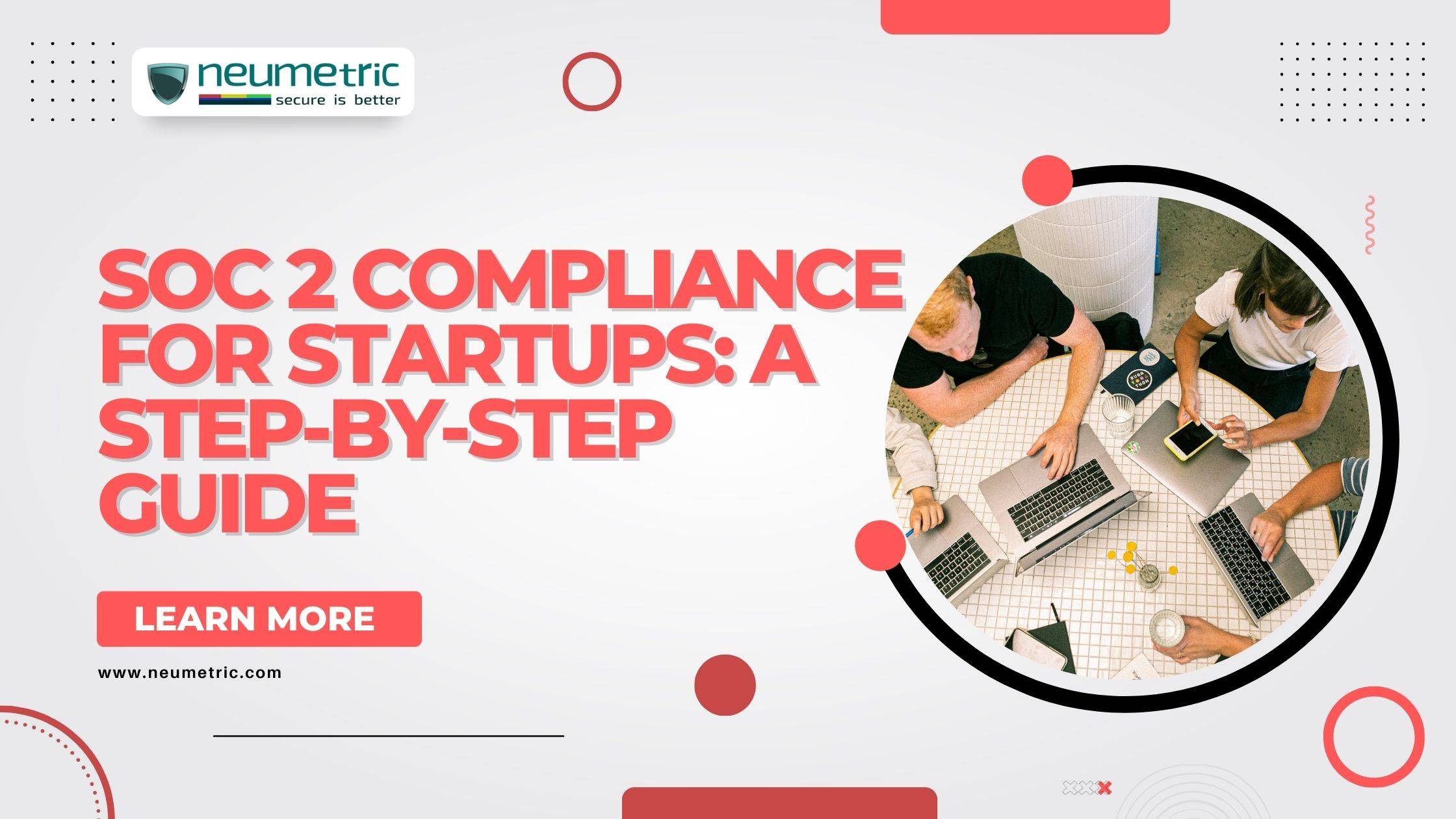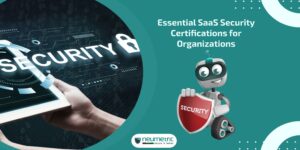Table of Contents
ToggleIntroduction
In the dynamic landscape of cybersecurity, startups face increasing pressure to safeguard sensitive data & assure clients of their commitment to robust information security practices. One significant avenue for achieving this is through obtaining Service Organization Control [SOC 2] compliance. This introductory section provides a concise exploration of SOC 2 compliance for startups, its pivotal role for startups & the myriad benefits it brings.
SOC 2 compliance, established by the American Institute of Certified Public Accountants [AICPA], is a comprehensive framework designed to assess & ensure the security, availability, processing integrity, confidentiality & privacy of sensitive data. Unlike other compliance standards, SOC 2 is particularly relevant for service providers storing customer information in the cloud.
For startups, often navigating the delicate balance between growth & security, SOC 2 compliance is a crucial differentiator. It signifies a commitment to establishing & maintaining a secure information infrastructure, bolstering client trust & satisfaction. As startups increasingly become prime targets for cyber threats, SOC 2 compliance becomes a proactive measure to mitigate risks, fostering a resilient foundation for sustained success.
Understanding SOC 2
SOC 2, short for Service Organization Control 2, is a framework established by the American Institute of Certified Public Accountants [AICPA] to ensure that organizations securely manage & protect the data they store in the cloud. Unlike other compliance standards, SOC 2 is specifically designed for technology & cloud computing organizations, making it particularly relevant for startups leveraging cloud-based services.
Key Principles of SOC 2 Compliance:
Security: The fundamental idea of SOC 2 compliance is security. This includes safeguarding infrastructure, data & systems from potential breaches & unauthorised access. Access controls, encryption & other security measures are put in place to protect sensitive data’s integrity & confidentiality.
Availability: This refers to the requirement that information & systems be continuously available & functional. Startups need to show that their downtime is kept to a minimum & that their services are dependable in order to guarantee that customers can access their data whenever needed. In the context of cloud-based services, where continuous availability is critical, this principle is essential.
Processing Integrity: Organisations must protect the integrity of their data processing in order to comply with SOC 2. This entails making certain that data is processed promptly, thoroughly & accurately. Throughout the processing lifespan, controls & procedures are put in place to stop mistakes, data corruption & deliberate manipulation.
Confidentiality: The goal of the confidentiality concept is to prevent unauthorised disclosure of sensitive information. Startups need to have policies in place to restrict access to digital & physical confidential data & protect against security lapses that can jeopardise the privacy of customer data.
Assessing Your Startup’s Readiness
Getting Ready for SOC 2 Compliant
Startups need to evaluate their current information security procedures internally before starting the SOC 2 compliance process. This entails assessing how policies, practises & technological controls are currently set up. The internal evaluation provides the basis for comprehending the gaps that must be filled in order to comply with SOC 2.
Internal Assessment: New businesses must examine their current data management procedures, security setup & information handling procedures in general. Reviewing the policies pertaining to incident response, access controls & data security is part of this internal assessment. It also comprises determining what needs to be improved & assessing how effective the security measures in place are right now.
Determining Scope & System Boundaries: One of the most important steps in getting ready for SOC 2 compliance is defining the scope & system boundaries. Startups need to specify exactly which data, systems & procedures are under SOC 2’s jurisdiction. This entails being aware of how data moves, how to engage with services provided by third parties & what outside influences might affect the information systems’ security.
Gap Analysis: To perform a gap analysis, one must compare the startup’s security measures as they stand now with the SOC 2 framework’s standards. This procedure finds the holes & flaws that must be fixed in order to attain compliance. It acts as a guide for creating & putting into place the controls required to satisfy SOC 2 requirements.
Building a Cross-Functional Team
Putting Together a SOC 2 Compliance Group
It takes a team effort & knowledge from several organisational domains to achieve SOC 2 compliance. Putting together a committed SOC 2 compliance team is essential to the smooth operation of a compliance programme.
Roles & duties: To guarantee responsibility & clarity, clearly define roles & duties within the compliance team. A compliance officer, legal counsel, IT security specialists & delegates from pertinent business divisions are examples of key positions. Assign distinct roles to duties like developing policies, putting them into practise technically & maintaining constant oversight.
Training & Awareness Programmes: Ensure that all team members have received thorough training so they can all understand the SOC 2 requirements & their respective responsibilities for attaining compliance. Training on the intricacies of the SOC 2 framework, pertinent security protocols & the significance of following policies & procedures might be part of this.
Communication Techniques: Throughout the SOC 2 compliance process, effective communication is crucial. Provide unambiguous routes of communication for the team & important stakeholders. Frequent updates regarding advancements, obstacles & significant events promote openness & guarantee that all parties are working together to attain & sustain SOC 2 compliance.
Creating Policies & Procedures – SOC 2 compliance for startups
Formulating Security Guidelines
A key component of SOC 2 compliance is the creation of thorough security policies, which provide the framework for how a company handles & safeguards its sensitive data. Each of these policies, which cover different facets of information security, is essential to establishing & upholding compliance.
Access Control: Policies for access control specify how systems & users are able to access sensitive data. To guarantee that only people with permission can access particular data or systems, roles, permissions & authentication procedures must be set up. Ensuring the confidentiality & integrity of sensitive information is contingent upon the implementation of this policy.
Data Classification: Policies for data classification group information according to its significance & level of sensitivity. This helps businesses to safeguard the most important data first & prioritise their security efforts. In order to ensure that the proper security measures are applied to different categories of information, startups must properly design & implement data classification policies in order to comply with SOC 2 regulations.
Incident Response: Policies for incident response specify the steps to be taken in case of a security occurrence. Lessons learnt & identification, containment, eradication & recovery from security breaches are all included in this. In order to meet SOC 2 criteria & reduce the effect of security incidents, it is imperative to have a clearly defined incident response policy.
Change Management: Change management policies dictate how changes to systems, processes, or configurations are managed. This includes documenting & assessing the impact of changes, obtaining approvals & ensuring that changes are implemented securely. Change management is vital for maintaining the stability & security of information systems.
Implementing Security Measures
Encryption: Data is protected during transmission & storage by encryption, a basic security mechanism. In order to meet the encryption criteria specified in the SOC 2 framework & guarantee the confidentiality of sensitive information, startups must deploy encryption technologies.
Access Controls: Technology must be used to implement access controls as outlined in security regulations. This comprises role-based access restrictions, user authentication systems & other technologies that uphold the need-to-know & least privilege concepts.
Multi-Factor Authentication: Going beyond simple username & password authentication, Multi-factor Authentication [MFA] offers an extra degree of protection. To improve access security & satisfy SOC 2 standards for strong authentication procedures, startups should use multi-factor authentication [MFA].
Data Center Security: For startups leveraging data centers, ensuring physical security is crucial. This involves implementing measures such as access controls, surveillance systems & environmental controls to protect the physical infrastructure hosting sensitive data.
Device Management: Managing physical devices, such as laptops & servers, is part of maintaining a secure environment. This includes measures like asset tracking, secure configuration & proper disposal procedures to prevent unauthorized access or data breaches through physical means.
Continuous Monitoring & Improvement
Continuous Risk Evaluations: The first step in continuous monitoring is regular risk assessments, which are a proactive method of locating, evaluating & ranking possible threats to the information systems of the company. In order to keep ahead of new threats & maintain the efficacy of their security procedures, startups regularly review their risks.
Regular Audits & Assessments: Regular audits & assessments are essential components of continuous monitoring. Conducting periodic internal audits & assessments helps startups validate the effectiveness of their security controls & identify areas for improvement. These assessments may include technical evaluations, policy reviews & vulnerability scans to ensure ongoing compliance with SOC 2 requirements.
Preparing for the SOC 2 Audit
Choosing the Correct Audit: Getting in touch with a certified SOC 2 auditor is a crucial first step towards compliance. Startups need to pick an auditor carefully who has knowledge of SOC 2 requirements & has worked in their business. The proper auditor will contribute to a good audit conclusion by offering insightful advice & assistance at key points in the process.
First Scoping Conference: Startups & the auditor usually have a scoping meeting before the audit officially starts. This meeting lays out the precise systems & procedures that will be evaluated, defines expectations & sets the audit’s scope. Effective communication is essential for a seamless & productive audit process throughout this stage.
Conducting the SOC 2 Audit
Analysing Policies & Procedures: The startup’s information security policies & procedures are carefully examined as the first step in the SOC 2 audit process. Auditors evaluate if these documents meet SOC 2 requirements, making sure that they are clearly stated & used uniformly throughout the company. This stage examines incident response strategies, data handling protocols, access controls & other important security regulations.
Technical Testing & Validation: As part of the audit, auditors evaluate the efficacy of the put in place security measures through technical testing & validation. This include checking for security flaws in the organization’s systems, confirming that access controls are operating as intended & making that encryption methods are being followed correctly. Technical testing confirms the reliability & integrity of the startup’s information systems & offers a practical assessment of its security posture.
Addressing Auditor Queries: During the audit, collaboration with auditors is paramount. Startups should expect & be prepared to address queries related to their security practices. Clear & transparent communication is key, as auditors seek to gain a comprehensive understanding of the implemented controls. Addressing these queries promptly & thoroughly demonstrates the organization’s commitment to transparency & cooperation.
Types of SOC 2 Reports
SOC 2 Type I: This report evaluates the suitability of the design of controls at a specific point in time. It assesses whether the startup’s systems & procedures are designed to meet SOC 2 criteria. While informative, it provides a snapshot rather than an extended assessment of operational effectiveness.
SOC 2 Type II: A more comprehensive report, SOC 2 Type II evaluates the operational effectiveness of controls over a specified period, typically a minimum of six months. It not only considers the design of controls but also assesses how well they are implemented & maintained over time.
Conclusion
In conclusion, securing startup success through SOC 2 compliance is a multifaceted journey that demands careful planning, commitment & ongoing dedication to information security. From understanding the core principles of SOC 2 to building cross-functional teams, creating robust policies, implementing security measures & undergoing continuous monitoring, startups are equipped with a comprehensive guide to fortify their digital infrastructure.
The culmination of these efforts leads to the SOC 2 audit, a critical milestone where startups showcase their commitment to data security & regulatory compliance. The audit process, involving policy examinations, technical testing & collaboration with auditors, is a testament to the organization’s proactive approach in safeguarding sensitive information.
Encouraging startups to prioritize & maintain SOC 2 compliance is not just a regulatory necessity but a strategic investment. By adhering to these principles, startups not only meet industry standards but also instill confidence in clients, partners & stakeholders. This commitment to information security not only shields the organization from potential threats but also fosters a culture of continuous improvement, adaptability & long-term success in an ever-evolving digital landscape. As startups navigate the intricate terrain of data security, SOC 2 compliance stands as a beacon, guiding them towards a secure, resilient & prosperous future.
FAO’s
- What are the first steps a startup should take to initiate SOC 2 compliance?
The initial steps involve understanding SOC 2 principles, conducting internal assessments, identifying system boundaries, and performing a gap analysis to gauge readiness for compliance.
- How can startups build an effective cross-functional team for SOC 2 compliance?
Assembling a SOC 2 compliance team requires defining roles, implementing training programs, and establishing clear communication strategies.
- Is SOC 2 compliance a one-time process, or does it involve ongoing efforts for startups?
SOC 2 compliance is not a one-time task. It involves continuous efforts such as regular risk assessments, audits, and adapting to changes in technology and regulations.





